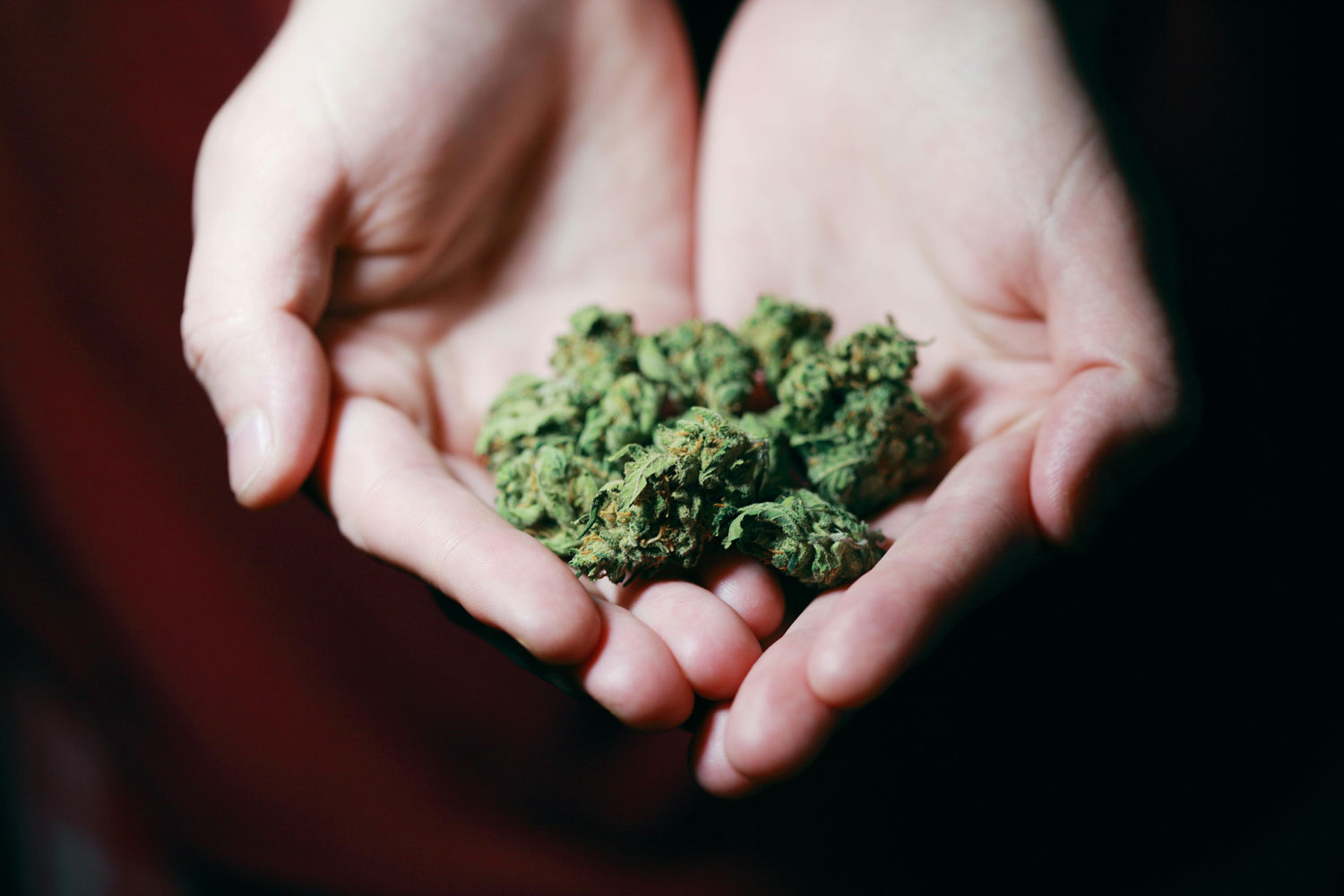How Long Does Weed Stay in Your Hair?

- Weed produces THC-COOH, which is absorbed into your bloodstream and eventually your hair follicles.
- THC is the primary psychoactive ingredient in cannabis.
- Depending on metabolism, dosage, hair color, hair health, and frequency of use, THC-COOH can be detected for up to 90 days in hair follicles.
- A hair follicle test cannot distinguish between firsthand and secondhand use.
- Other THC tests include urine tests, saliva tests, and blood tests.
THC is the primary psychoactive element of weed or cannabis. Detection timelines depend on metabolism, dosage, and frequency of use. However, in most cases, THC can be detected in hair for up to 90 days.
The Mechanics of Smoking Weed
“Weed” is the slang word for marijuana or cannabis. Cannabis is a psychoactive drug that alters your perception of reality, mental processes, mood, and emotions. The active ingredients in cannabis are THC and CBD. Of these, CBD is not psychoactive, whereas THC is. THC and its metabolite, “THC-COOH,” will be the focus of this article.
When THC enters the body, your body breaks it down, uses it, and stores it. When THC is metabolized, it creates a metabolite called “THC-COOH.” The official name of “THC-COOH” is 11-nor-9-carboxy-Δ⁹-tetrahydrocannabinol.[1] THC and “THC-COOH” are both present in your body after smoking weed.
The original THC will be mostly eliminated from your system in 3 to 6 hours. This can be detected by breathalyzer machines and is of concern for blood saturation limits during roadside drug testing by the police.
The THC metabolite “THC-COOH” is lipid soluble, or fats. This means “THC-COOH” is rapidly absorbed by fat tissue in your body, where it accumulates. From these fat deposits, it is slowly released back into the bloodstream.[2]
Because it gets released back into your bloodstream, “THC-COOH” will get distributed around the body. Your hair follicles are all connected to your bloodstream. Each hair follicle has a blood vessel to feed the hair growth cells, so any drugs are carried from the blood into the hair follicle.[3] Consequently, traces of THC-COOH can also be detected in hair follicle samples.
Like tree rings can tell a trained biologist about the climate when a new ring was formed, your hair can tell a scientist what you have been absorbing when it was formed. “THC-COOH” will be eliminated in your hair follicles in 90 days.[4]
This will impact workplace accident testing or child custody cases where income or parental rights can be lost based on the presence of detected cannabinoids. Drug tests will involve cutting hair follicles and testing them for the presence of the lipid-soluble “THC-COOH.”
What Is A Hair Test For Weed?
In preparation for a hair test, consider the following:
- How long has it been since the last use, if at all?
- What type of test is being used? (Breathalyzer, hair follicle, etc.)
- Are you a heavy, light, or non-user?
- Do you use hair-darkening products?
- Are you associated with anyone who smokes weed?
- Is there any way they could have transferred it to your person?
How Does a Hair Follicle Test Work for Weed?
Hair is like a living record of what you have absorbed into your body. Each 1.5 inches of hair represents about 90 days of growth. You will be asked to provide a hair sample, and the 1.5 inches nearest to the scalp will be tested.
🌿 How Long Does Weed (THC) Stay in Your System?
Consumption frequency is the single most important factor influencing how long THC remains detectable. The chart below details the estimated time frames for different usage habits across the most common drug screening tests.
| Consumption Frequency | Estimated Detection Window | Testing Method |
|---|---|---|
| Single Use (Rare) | 1 to 3 Days | Urine Test |
| Moderate Use (A few times per week) | 7 to 21 Days | |
| Chronic Daily Use (Heavy) | 30 Days or More (up to 60-90 days) | |
| Recent Use (Within hours) | 1 to 3 Days | Saliva Test |
| Recent Use / Heavy Use | 1 to 7 Days | Blood Test |
| General History | Up to 90 Days | Hair Follicle Test |
Why Does Weed Stay in Your Hair?
When THC metabolizes in your body, it creates “THC-COOH.” The metabolite “THC-COOH” is lipid-soluble, which means it gets absorbed into your fat tissue. It will get slowly released back into your bloodstream.
Each one of your hair follicles is attached to a blood vessel. As your hair growth cells get fed, the hair that is grown will contain traces of any substances in your blood. In this case, the substance is “THC-COOH.”
How Long is Weed Detectable in Hair Follicles?
You can test positive for weed in your hair follicles for up to 90 days.
Factors That Impact Weed Detection Window in Your Hair
There are several factors that can influence THC or THC-COOH detection in hair follicle tests. Marijuana use affects people differently depending on genetics and environment.
Individual Metabolism
Your body mass index (BMI) is the ratio of your height to weight. It’s meant to measure the amount of body fat you have.[5] Body fat is made up of fat cells, and earlier, we discussed that the metabolite THC-COOH is lipid-soluble. Lipids are fats.
So, since THC-COOH is fat-soluble, the more fat you have, the more THC-COOH will get absorbed into your body. The more that gets absorbed into your body, the longer it will take to eliminate it.
Frequency of Use
Frequency of ingestion is probably the number one factor that impacts detection in hair follicles. In a study documenting cannabis use and subsequent detection in hair follicles, 77% of heavy users, 39% of light users, and 0% of non‐users tested positive for THC.[6]
This study shows that even though 100% of both heavy and light users of cannabis used THC, heavy users were 38% more likely to test positive than light users. Prior to testing, the amount of time since last use was not greater than 90 days.
Hair Health
Bleaching, coloring, and relaxing your hair can alter the chemical composition of your follicles. It may invalidate them as an accurate representation and untreated hair may need to be taken from a different area of your body.
Hair Color
Other drugs like cocaine bind more strongly to melanin, which is in greater content in dark hair.[7] Dark hair is more prevalent in certain racial groups, like in Black and Hispanic communities. The influence of melanin on cannabis has not been tested, so the cause/effect relationship cannot be known with certainty.
Method of Ingestion
The amount of THC varies enormously between the concentration in products containing THC, such as smoking, vaping, edibles, topicals, and tinctures. Using one or more of these in combination could make it more likely to yield a positive result in a hair follicle test.
Can a Hair Test Produce a False Positive?
No. If THC is detected, it means there is THC or a metabolite in your system. What can be false, though, is whether or not you were the primary user of the drug. There is scientific evidence that “THC-COOH” can also be present in the hair of non-consuming individuals because of transfer through cannabis consumers via their hands, their sebum/sweat, or cannabis smoke.[8]
Be cautious to avoid cannabis users prior to a drug test, as the hair follicle test cannot distinguish between firsthand and secondhand exposure.
Overcome Cannabis Addiction With Holistic Treatment
From medical detox to intensive outpatient programs, holistic therapies, and individualized treatment are the paths forward to overcoming a cannabis addiction and ensuring your sobriety. If you or a loved one needs rehab for weed we can help.
Frequently Asked Questions About Weed Detection In Hair and Other Drug Tests


